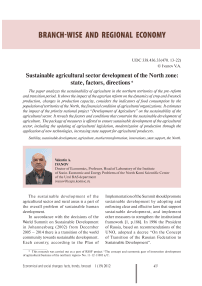Sustainable agricultural sector development of the north zone: state, factors, directions
Автор: Ivanov Valentin Aleksandrovich
Журнал: Economic and Social Changes: Facts, Trends, Forecast @volnc-esc-en
Рубрика: Branch-wise and regional economy
Статья в выпуске: 1 (19) т.5, 2012 года.
Бесплатный доступ
The paper analyzes the sustainability of agriculture in the northern territories of the pre-reform and transition period. It shows the impact of the agrarian reform on the dynamics of crop and livestock production, changes in production capacity, considers the indicators of food consumption by the population of territories of the North, the financial condition of agricultural organizations. It estimates the impact of the priority national project “Development of Agriculture” on the sustainability of the agricultural sector. It reveals the factors and conditions that constrain the sustainable development of agriculture. The package of measures is offered to ensure sustainable development of the agricultural sector, including the updating of agricultural legislation, modernization of production through the application of new technologies, increasing state support for agricultural producers.
Stability, sustainable development, agriculture, market transformation, innovations, state support, north
Короткий адрес: https://sciup.org/147223324
IDR: 147223324 | УДК: 338.436.33(470.
Текст научной статьи Sustainable agricultural sector development of the north zone: state, factors, directions
The sustainable development of the agricultural sector and rural areas is a part of the overall problem of sustainable human development.
In accordance with the decisions of the World Summit on Sustainable Development in Johannesburg (2002) from December 2005 – 2014 there is a transition of the world community towards sustainable development. Each country, according to the Plan of
Implementation of the Summit should promote sustainable development by adopting and enforcing clear and effective laws that support sustainable development, and implement other measures to strengthen the institutional framework [1, p.186]. In 1996 the President of Russia, based on recommendations of the UNO, adopted a decree “On the Concept of Transition of the Russian Federation to Sustainable Development”.
The concept seeks to “implement in the Russian Federation the gradual transition to sustainable development, providing the solution of social and economic problems and problems of preservation of favorable environment and natural resources to meet the needs of present and future generations”.
The need to move agriculture in the North Zone for sustainable development is due to build-up of production of local food products, supplying the population with ecologically safe products produced in this macroeconomic region and other parts of the country as well, the solution of employment problems of the indigenous population, increasing standards of living of the peasant community, a stable and balanced nature management.
At present, agriculture in the North Zone is characterized as unstable. In this regard, the development of science-based measures complex, aimed at stabilization and sustainable development of northern agriculture, is becoming an important and urgent task.
Analysis of sustainability of agriculture in the pre-reform period
In the history of agricultural development of northern territories 1960 – 1980-ies were the most favorable. The analysis of the dynamics of the efficiency of agricultural production for 30 years with the help of regression equations showed that in the European North the average growth of gross output per capita amounted to 1.5%, the unit of land – 4.4, and productivity in the public sector – to 5.7%. Moreover, these figures were higher here than the North-West economic region, respectively, 0.9, 1.3 and 1.1 percentage points.
The dynamics of crop and livestock production in 13 territories, which are all included of the Far North and equivalent areas, showed that the average annual production of vegetables in 1986 – 1990 compared with 1971 – 1975 increased by 19%, milk – by a quarter, and meat – almost twice, eggs – by 2.6 times.
In the pre-reform period the share of the European North accounted for over half (54%) of agricultural production in the North Zone. Changing production volumes in the pre-reform period is shown in figures 1 and 2 .
The strategy of agricultural development in the pre-reform period was determined by the intensification on the basis of strengthening its material-technical base. The development of material-technical base was achieved by the investment policy. As can be seen from the data for 1976 – 1990, investments grow in Russia as a whole, and in the regions, except the Murmansk region (tab. 1) .
Much work has been done on the mechanization of crop and livestock production. Particularly great progress has been made in terms of comprehensive mechanization in farming. Only the Republic of Yakutia had a low level of comprehensive mechanization in farming (tab. 2) .
In the pre-reform period in the agricultural sector of the North were introduced crop rotations, new crop varieties, new technologies of their cultivation, measures to improve soil fertility, science-based farming systems, intensive forage production systems, advanced fodder technologies, mechanized seed and herbs production technologies.
In livestock farming near the cities the construction and development of cattlebreeding complexes and poultry farms were in progress. During these years in many regions of the North was almost solved the problem of ensuring the needs of the population in eggs. It was promoted by the translation of the industry on an industrial basis.
Consumption indicators of food by the residents of the northern territories approached and for some territories exceeded the national average (tab. 3) . In 1991, the share of local resources in the formation of food stocks, such as in the Komi Republic, reached 94% for potatoes, vegetables – 21, milk – 48, meat – 40, eggs – 91%.
Figure 1. Crop production in all categories of farms in the regions, which territories are fully included in the North Zone, thousands of tons
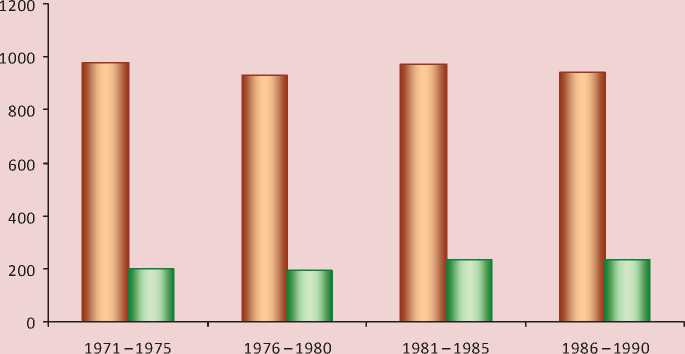
□ Potatos □ Vegetables
Figure 2. Livestock production in all categories of farms in the regions, which territories are fully included in the North Zone, thousands of tons
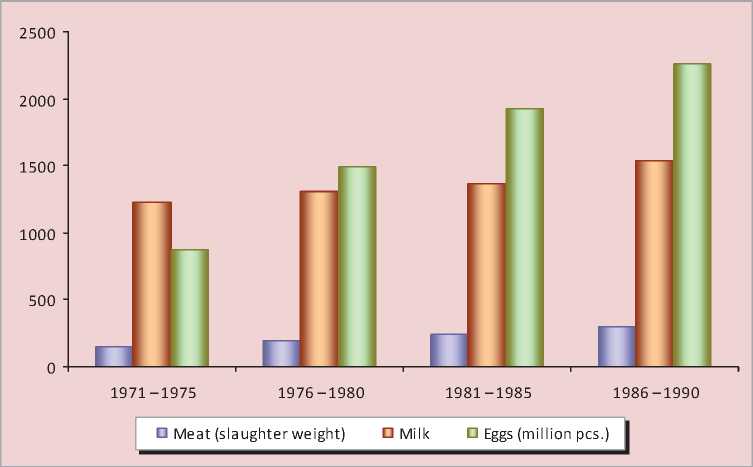
There were positive changes in the approximation of conditions and living standards of urban and rural populations, as well as in pricing based on the increase in purchase prices for agricultural products and financial status of farms. In 1990, all state and collective farms were profitable (tab. 4). The level of profitability was consistent with the optimal rate (40 – 50%), allowing to carry out the process of expanded reproduction. Products of traditional industries had high level of profitability, especially the meat of deer. In 1990, the profitability of deer meat in the Yamalia Autonomous Okrug was 426%, the Nenetsia Autonomous Okrug – 424, the Komi Republic – 324, the Chukotka Autonomous Okrug – 274, the Republic of Sakha (Yakutia) – 208%.
Table 1. Capital investment in agriculture*, millions of rubles
|
Republic, region |
Years of 1976 – 1980 |
1981 – 1985 |
1986 – 1990 |
1986 – 1990 to 1976 – 1980, % |
|
RSFSR, bln. rub. |
121.5 |
138.6 |
173.8 |
143 |
|
Non-Chernozem zone |
41.4 |
46.5 |
57.2 |
138 |
|
Karelia Republic |
390 |
431 |
625 |
160 |
|
Komi Republic |
447 |
486 |
615 |
138 |
|
Arkhangelsk region |
1016 |
1131 |
1450 |
143 |
|
Murmansk region |
805 |
611 |
772 |
96 |
|
Tuva Republic |
375 |
376 |
468 |
125 |
|
Sakha Republic (Yakutia) |
636 |
896 |
1613 |
254 |
|
Kamchatka region |
684 |
877 |
1293 |
189 |
|
Magadan region |
403 |
547 |
766 |
190 |
|
Sakhalin region |
795 |
892 |
1403 |
176 |
|
Source: The development of agro-industrial complex of the RSFSR: stat. book. Goskomstat of the RSFSR. M., 1991. P. 79, 80. * Territorial units are given in the present status. |
||||
Table 2. The level of mechanization in agricultural regions, which territories are fully included in the North Zone (1990), %
|
Republic, region |
Vegetables planting |
Potatoes combining |
Comprehensive mechanization level in farms and complexes |
||
|
cattle |
milk |
pig-breeding |
|||
|
Karelia Republic |
99 |
29 |
59 |
76 |
57 |
|
Komi Republic |
91 |
38 |
54 |
75 |
80 |
|
Arkhangelsk region |
82 |
83 |
54 |
76 |
85 |
|
Murmansk region |
50 |
22 |
59 |
64 |
86 |
|
Tuva Republic |
49 |
36 |
35 |
71 |
75 |
|
Sakha Republic (Yakutia) |
49 |
26 |
5 |
12 |
55 |
|
Kamchatka region |
93 |
60 |
93 |
95 |
90 |
|
Magadan region |
97 |
37 |
75 |
94 |
85 |
|
Sakhalin region |
89 |
3 |
62 |
79 |
74 |
Source: The development of agro-industrial complex of the RSFSR: stat. book. Goskomstat of the RSFSR. M., 1991. P. 89, 90.
Table 3. The consumption of main types of food products per capita in 1990, kg
|
Indicator |
Meat and meat foods |
Milk and dairy products |
Eggs, pcs. |
Potatoes |
Vegetables, melons and gourds |
Sugar |
Bread products |
|
Science-based norm |
88 |
440 |
290 |
110 |
140 |
43 |
110 |
|
RSFSR |
75 |
387 |
297 |
106 |
89 |
47 |
120 |
|
Karelia Republic |
57 |
375 |
321 |
82 |
75 |
42 |
111 |
|
Komi Republic |
72 |
402 |
294 |
97 |
92 |
56 |
118 |
|
Arkhangelsk region |
61 |
363 |
295 |
65 |
71 |
49 |
113 |
|
Murmansk region |
67 |
390 |
249 |
61 |
75 |
50 |
69 |
|
Tuva Republic |
58 |
299 |
222 |
44 |
49 |
46 |
126 |
|
Sakha Republic (Yakutia) |
80 |
433 |
267 |
74 |
82 |
56 |
109 |
|
Kamchatka region |
82 |
342 |
285 |
58 |
101 |
58 |
94 |
|
Magadan region |
100 |
412 |
258 |
87 |
114 |
54 |
96 |
|
Sakhalin region |
74 |
378 |
318 |
86 |
116 |
61 |
127 |
|
Source: Regions of Russia. Socio-economic indicators. 2008: stat. book. Rosstat. M., 2008. Pp. 194-201. |
|||||||
Table 4. The level of profitability, unprofitability (-) of production in the farms of regions, which territories are fully included in the North Zone (1990),%
|
Republic, region |
Agriculture |
Plant growing |
Livestock |
|
Karelia Republic |
44 |
14 |
16 |
|
Komi Republic |
44 |
22 |
46 |
|
Arkhangelsk region |
51 |
43 |
51 |
|
Murmansk region |
48 |
13 |
51 |
|
Tuva Republic |
41 |
-14 |
44 |
|
Sakha Republic (Yakutia) |
152 |
-3 |
168 |
|
Kamchatka region |
69 |
25 |
76 |
|
Magadan region |
68 |
-18 |
77 |
|
Sakhalin region |
46 |
24 |
50 |
|
Source: The development of agro-industrial complex of the RSFSR: stat. book. Goskomstat of the RSFSR. M., 1991. P. 306, 307. |
|||
Budgetary provisions had a significant impact in the sources of expanded reproduction. For example, in the Komi Republic, for 1976 – 1980 the average share of the state budget in the sources of the capital stock and growth of working capital was 43%, for 1981 – 1985 – 37, for 1986 – 1988 – 31% [2, p. 148].
The most important direction of the social policy in the pre-reform period was the convergence of conditions and living standards of urban and rural populations. Steadily increased total income of rural families, their level was gradually approaching the urban settings. In the Republic of Komi, for example, in 1989 the total income for rural families was 82.5% compared to the urban family, and the average total income of rural residents to the level of citizens – 72.4%. Average monthly wage of agricultural workers was 236 rub., on the whole national economy – 282 rub., in the industry – 325 rub., construction – 333 rub., transportation – 327 rub. [3, p. 21]. There was a clearly discernible trend towards higher levels of provision of rural population with different kinds of services and social amenities, comprehensive development of the central estates farms as base stations in rural areas was carried out.
Thus, the agricultural policy in the prereform period, aimed at accelerating the pace of intensification and industrialization of agricultural production, improving living standards of peasants, promoted the economic and social stability of the agricultural sectors of the North Zone. In the early 1990-ies in the North the minimum necessary amount of food necessary for sustainable livelihoods was produced.
The consequences of market reforms on the stability of agricultural economy
In the course of market reforms in the countryside there are conflicting socioeconomic processes. In recent years, were largely created the legal and organizational conditions for the functioning of various forms of ownership and management, including the foundations of market mechanisms. The state monopoly on land was abolished. The vast majority of agricultural production and the entire field of processing and marketing of agricultural products have been privatized. Agricultural producers have the right to choose forms of management, complete freedom in the implementation of their products, the acquisition of material resources and the use of proceeds.
Currently, most villagers have gained ownership on the land. The property right was transferred to the peasants for property and land shares, the size of personal land was increased and restrictions on private farming, housing and homestead construction were removed. Access to land is open to residents. In terms of economic restructuring, and the associated increase in the number of unemployed, deteriorating financial situation, granting citizens with the ground for conducting a commodity and a household is an important element of social protection.
A new socio-economic structure of agricultural production, characterized by the presence of private, collective and individual legal organizational forms of management was created. Currently in the North Zone a collective, private plots, peasant-farming way of life is operating. A variety of legal forms was formed: industrial and agricultural cooperatives, business partnerships and companies, state unitary enterprises and private farms.
The transition to a market economy was accompanied by a reduction in agricultural production especially livestock. Over the years 1990 – 2009 meat production decreased by 3.3, milk – by 2.5, eggs – by 2.2 times (fig. 3) .
Falling production has identified the reduction of consumption of local foods. For example, in the Komi Republic for 1990–2010 percentage of local food consumption in relation to science-based consumption rates decreased for meat and meat products from 34.7 to 22.5%, milk and dairy products – from 37.7 to 15.5, eggs – from 101.4 to 97.9 %. Despite the significant import in regions of the North of food, food consumption is now lower
(except meat and meat products, potatoes, vegetables and melons, bread products in a number of territoties) (tab. 5) .
During the years of reforms occurred the degradation of production potential. Sown areas for 1990 – 2009 decreased from 1055.6 thousand hectares to 324.7, the number of cattle decreased from 1599.7 thousand to 567.9 thousand head, including cows – from 603.3 to 241.4, pigs – from 1144.4 to 221.4 thousand, deer – from 2260.3 to 155.3 thousand head.
In plant growing there is deterioration of agrochemical and hydrophysical properties of soils, increase of waterlogged and bushing lands in connection with the destruction of drainage systems and reduction in land reclamation. Drastically reduced application of mineral and organic fertilizers.
There is organizational, technical and technological backwardness of the industry. Tractors park of all brands in agriculture, such as of the Komi Republic for 1990 – 2010 decreased from 5477 pcs. to 971, the amount of generating capacity – from1507.9 thousand HP to 293.7. There is a reduction of tractors and power facilities on 100 hectares of crops, while increasing area of farmland per 1 worker (fig. 4) . A similar situation in other regions of the North.
Figure 3. Livestock production in all categories of farms in the regions, which territories are fully included in the North Zone for 1990 – 2009, thousands of tons
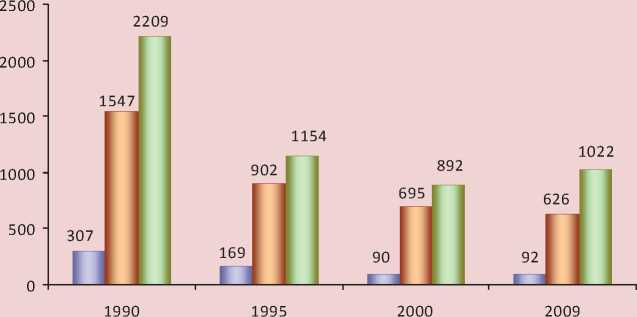
п Meat (sla ughter we ight) □ Milk □ Eggs (million pcs.)
Table 5. The ratio of consumption of basic food products per capita in 2009 to 1990, %
|
Country, region of the Federation |
Meat and meat foods |
Milk and dairy Products |
Eggs pcs. |
Potatoes |
Vegetables and melons |
Sugar |
Bread products |
|
Russia |
89 |
64 |
88 |
107 |
116 |
79 |
99 |
|
Karelia Republic |
114 |
63 |
74 |
124 |
115 |
98 |
105 |
|
Komi Republic |
99 |
58 |
86 |
56 |
90 |
68 |
92 |
|
Arkhangelsk region |
82 |
44 |
83 |
112 |
104 |
80 |
96 |
|
Murmansk region |
97 |
61 |
89 |
115 |
154 |
70 |
139 |
|
Tuva Republic |
95 |
56 |
37 |
218 |
78 |
52 |
105 |
|
Sakha Republic (Yakutia) |
109 |
66 |
77 |
112 |
88 |
63 |
123 |
|
Kamchatka region |
79 |
44 |
54 |
155 |
96 |
57 |
103 |
|
Magadan region |
69 |
53 |
74 |
78 |
70 |
65 |
114 |
|
Sakhalin region |
116 |
54 |
68 |
131 |
76 |
52 |
81 |
|
Calculated: 1. Regions of Russia. Socio-economic indicators. 2008: stat. book. Rosstat. M., 2008. Pp. 194-201. 2. Regions of Russia. Socio-economic indicators. 2010: stat. book. Rosstat. M., 2010. Pp. 200-207. |
|||||||
Figure 4. The changing of the availability of agricultural land, tractors and power capacities in agriculture of the Komi Republic, 1990 = 100%: 1 – power capacity for 100 ha of crops, 2 – tractors per 100 hectares of crops, 3 – agricultural grounds for one employee
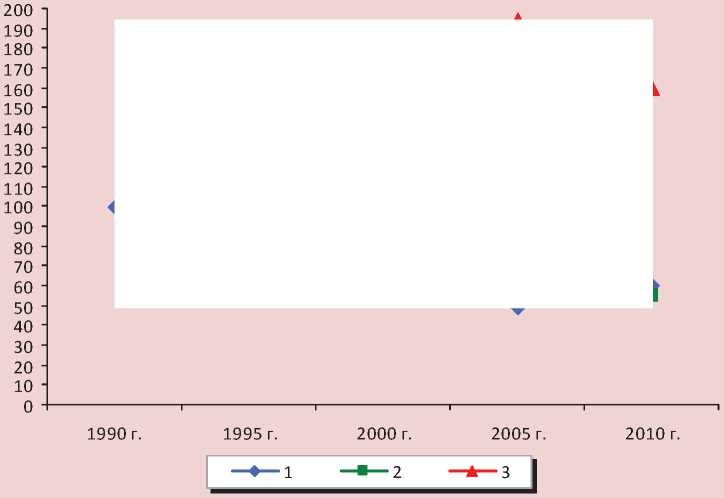
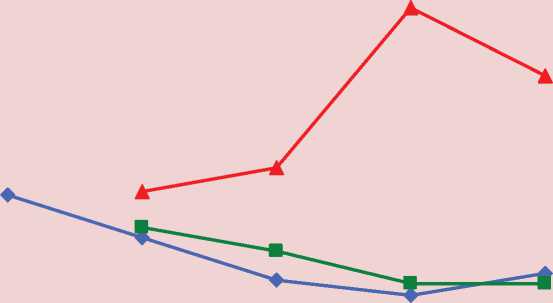
In the agricultural organizations of the North was violated the principle of selfsufficiency and self-financing. Over the past three years the share of unprofitable organizations ranged from 30 to 42. The level of profitability is 4–5 times lower than normal, necessary for the implementation of expanded reproduction.
Extremely low remains the level of profitability of livestock production, the leading industry in the region. Beef production is unprofitable. The data on the level of profitability (unprofitability) of agricultural organizations in the regions, which territories are fully included in the North zone, shown in table 6 .
Table 6. The level of profitability (unprofitability) of economic activity of agricultural organizations, %
|
Country, region of the Federation |
Of all economic activities |
Of crops production |
Of livestock production |
|||||||||
|
Year of 2005 |
2006 |
2007 |
2008 |
2005 |
2006 |
2007 |
2008 |
2005 |
2006 |
2007 |
2008 |
|
|
Russia |
8.1 |
10.3 |
16.2 |
14.5 |
20.5 |
27.2 |
48.5 |
38.6 |
10.7 |
10.6 |
10.9 |
12.4 |
|
Karelia Republic |
6.1 |
1.3 |
0.6 |
2.8 |
42.5 |
21.2 |
18.2 |
8.3 |
5.3 |
5.1 |
5.1 |
2.4 |
|
Komi Republic |
5.5 |
8.1 |
7.6 |
15.8 |
7.5 |
6.0 |
8.3 |
9.7 |
3.9 |
12.7 |
10.6 |
15.5 |
|
Arkhangelsk region |
-2.6 |
1.1 |
14.6 |
17.3 |
-3.8 |
22.0 |
19.4 |
22.4 |
-1.3 |
2.4 |
10.4 |
6.7 |
|
including Nenetsia AO |
10.0 |
11.0 |
16.7 |
18.0 |
-28.7 |
-26.3 |
-6.9 |
- |
8.0 |
16.0 |
13.7 |
15.5 |
|
Murmansk region |
7.7 |
7.4 |
-0.5 |
2.5 |
49.7 |
22.1 |
33.3 |
13.5 |
12.6 |
17.0 |
13.8 |
8.3 |
|
Khantia-Mansia AO |
-2.6 |
-9.5 |
3.9 |
5.3 |
-10.3 |
10.4 |
-0.7 |
-20.5 |
-5.2 |
-16.6 |
14.9 |
-8.5 |
|
Yamalia AO |
-20.0 |
-11.6 |
17.8 |
22.4 |
-2.2 |
- |
-34.9 |
- |
2.6 |
7.1 |
0.4 |
41.7 |
|
Tuva Republic |
-15.9 |
-7.6 |
1.6 |
0.6 |
-14.3 |
-15.0 |
-20.7 |
-15.6 |
-6.4 |
3.6 |
19.8 |
19.5 |
|
Sakha Republic (Yakutia) |
6.3 |
2.6 |
10.4 |
11.9 |
33.4 |
12.5 |
37.9 |
48.6 |
15.0 |
21.0 |
11.9 |
20.6 |
|
Kamchatka region |
12.3 |
14.4 |
2.8 |
14.3 |
44.9 |
32.2 |
15.2 |
61.7 |
12.6 |
18.5 |
-2.3 |
15.4 |
|
Magadan region |
-2.7 |
-5.0 |
-13.5 |
-22.3 |
29.2 |
60.7 |
440.5 |
13.6 |
-22.7 |
-12.0 |
0.5 |
-7.7 |
|
Sakhalin region |
3.8 |
4.4 |
8.1 |
15.1 |
32.9 |
34.8 |
33.7 |
40.0 |
-9.0 |
-4.1 |
-4.8 |
-4.2 |
|
Chukotka AO |
118.6 |
145.0 |
150.9 |
72.2 |
-46.8 |
-30.4 |
-14.0 |
-19.9 |
89.4 |
71.6 |
100.1 |
-38.2 |
Source: Agriculture, hunting and forestry in Russia. 2009: stat. book / Rosstat. – M., 2009. – Pp. 406-407, 410-413.
The analysis of financial sustainability of agricultural enterprises in the Republic of Komi in 2009 showed that almost two-thirds (62%) of companies are financially stable. These organizations have the disadvantage of the total value of all sources for the formation of reserves and costs.
Positive changes in agriculture in the Northern Zone occur in connection with the implementation, since 2006, the national project “Development of agriculture”, transformed into “The state program of agricultural development and regulation of agricultural products markets, raw materials and food for 2008 – 2012”. The project is aimed at accelerating the development of livestock and promoting the development of small farms. For the implementation of measures for the development of animal husbandry are allocated budgets to subsidize interest rates on investment credits taken for up to 8 years for the construction and modernization of livestock farms.
The priority directions of development of small farms are: the establishment in settlements of supply and marketing cooperatives for the sale of goods by inhabitants, the expansion and creation of facilities for processing of agricultural products produced by personal subsidiary plots and farms, development provision of rural credit cooperatives (with the participation of Russian Agricultural Bank); forming of a system of land-mortgage lending; providing interest-free loan. For personal subsidiary plots preferential loan is granted in the amount of 300 thousand rubles; farms – up to 3 million, agricultural consumer cooperatives – up to 10 million rubles.
Analyzing the results of the national project “Development of agriculture”, it should be noted the increase in meat production, the mass of profit, declining share of loss-making agricultural organizations. However, we could not overcome the tendency of reducing number of cows and milk production (tab. 7) .
Taken in recent years, measures of state support of agricultural producers did provide the tendency of growth of production of individual products, but have not led to sustained economic growth. Major shifts in the quality of life in rural areas have not happened yet. Restrictive factors and conditions for sustainable agriculture development in the Northern Zone are shown in figure 5.
Table 7. Indicators of Agriculture in the Far North and similar territories for 2005 – 2010
Indicators Year of 2005 2006 2007 2008 2009 2010 2010 to 2005,% Livestock, thousand of head cattle 747.1 740.6 746.7 749.9 747.8 732.8 98.1 Including cows 330.7 324.6 326.0 323.0 322.4 314.2 95.0 pigs 221.3 247.9 265.5 267.7 275.5 287.8 130.0 deer 1297.9 1441.0 1458.8 1520.4 1553.0 1570.6 121.0 Food production, thousands of tons livestock and poultry for slaughter (in slaughter weight) 116.3 117.1 118.3 121.8 130.1 137.3 118.1 milk 816.3 801.0 800.8 789.1 789.1 770.3 94.4 Food production per capita, кg meat (in slaughter weight) 11 11 11 12 12 14 127.3 milk 76 75 76 75 75 76 100.0 Profit of agricultural organizations*, mln. rub 357 494 1302 1563 2429 - Unit weight of loss-making agricultural organizations,% 42 35 30 - * Data for 2008 – 2009 by regions, which territories are fully included in the zone of the North. Source: 1. Economic and social indicators in the Far North and equivalent areas in the 1998 – 2010 years. – M., 2011. – URL: // / bgd / regl / b10-22 / 2. Agro-industrial complex of Russia in 2009. – Moscow: Ministry of Agriculture, 2010. – P. 339, 340.
Figure 5. Restrictive factors and conditions for the sustainable development of the agricultural sector of the North
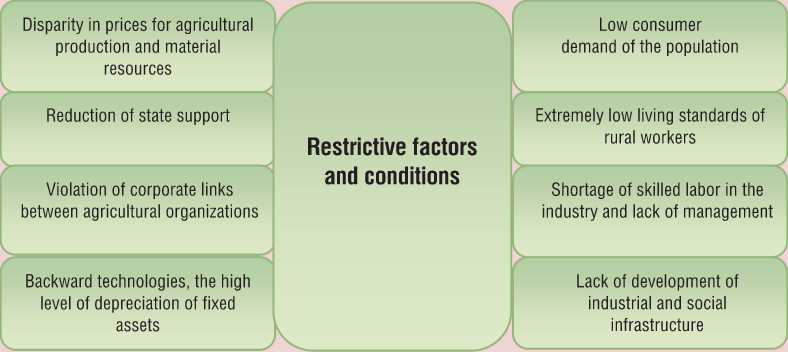
Investigation of the effect of the agrarian reform on the stability of individual industries and social types of enterprises, their adaptation to changing environmental conditions in the case of the Republic of Komi allowed to state the following. Since the mid-1990-ies in the Republic the meat poultry stably operates on the basis of self-regulation.
The presence of skilled management team in food subdivision ensured the rational use of available economic capacity and adaptation to the changing market environment. Agricultural companies specializing in the production of eggs, pork, venison and fish, are able to develop dynamically with maintaining government support.
More than 90% of agricultural organizations in cattle industry in the period of market reforms have lost economic and social sustainability. They without outside help can not get enough profit to build productive capacity and carry out expanded reproduction. The use of only internal factors is not enough for the stability of the region’s leading industry.
In the 1990-ies stable were organizations which were more attuned to the market, practically without any government support and in times of crisis increased production output. In the last decade in most northern regions there is an absolute and relative decline of production in farms. The vast majority of them belongs to the consumer type. According to the agricultural census in 2006 surplus meat was realized by only 1.6% of the population of farms in the Far North and equivalent territories, and milk – 2.6%.
By reducing the rural households, the deterioration of the demographic situation in the countryside, rural aging and a decline in its share of capable individuals, low production efficiency, based on manual unskilled physical labor, we should not make the emphasis on private sector citizens as a base for the formation of food stocks.
Farmer structure in the medium term in most regions of the North will not receive a significant development. Formation of the peasant farms requires a large investment to build the facilities and infrastructure, a lot of time, competence of work in the marketplace.
Measures to overcome the crisis and ensure the sustainable development of agriculture
Current economic, social and ecological state of the agrarian sector, primarily of peripheral (remote) rural regions of the North is characterized as unstable, which can get a very negative form associated with the elimination of agricultural production and the reduction of habitable rural area. To overcome the crisis and the transition of agriculture for sustainable development the package of measures was proposed (tab. 8) .
The main directions of the sustainable development of the agrarian sector of the northern territories are represented in the publication [4]. The priority areas are:
-
• to use new technologies, to implement balanced reproduction of the resource potential;
-
• to consider the North zone as a great reserve of production of ecologically pure products, and eventually a major exporter of organic products, generating additional rental income;
-
• formation of multi-functional economy in rural areas, associated with cooperation and integration, development of non-agricultural activities and recreational use of the countryside;
-
• increased government support of agricultural producers;
-
• creation of modern information and advisory systems of agricultural and rural development.
Innovation as a key factor for sustainable development of the agricultural sector
The objective need for enhancing innovation development of agrarian economy involves overcoming the technical and technological backwardness, stable operation of agricultural production, as well as higher incomes of rural workers. Sustainable Development Strategy for the agri-food complex taking into account the factors of innovation is crucial in the current situation.
The basis for the development of agricultural regions of the North, since the second half of the 60-ies – to early 90-ies of the last century has been the intensification of production. The agricultural sector introduced crop rotation, new crop varieties, new technologies of their cultivation, science-based farming systems, new animal breeds and crosses of birds, the industrial technologies of vegetable of greenhouse production, livestock products, new methods of processing raw materials and energy saving technologies in agricultural processing industries. This ensured the growth of agricultural production and improved its efficiency.
Table 8. The causes of the agrarian crisis and major measures of sustainable development of agriculture of the North
|
Causes of the crisis |
Necessary measures to stabilize and develop agriculture |
|
1. Underdeveloped legal and regulatory framework |
At the federal level it is required to develop and enact laws: “On the agriculture of the Russian Federation” [5. 32], “On the state regulation of imported agricultural products”, “On agricultural insurance”, “On the state agricultural enterprise”. At the level of northern regions the laws are to be adopted “On the reconstruction and development of agriculture”, “On innovation policies and strategies in agriculture.» |
|
2. Technical and technological backwardness, a high level of depreciation of fixed assets |
Modernization of agricultural production using the latest technologies and breeding and genetic innovations. |
|
3. Lack of financial resources for the implementation of expanded reproduction |
Full financial support for agricultural development will require increasing the budget in two to three times higher than before the crisis period. The share of consolidated budget expenditures of the regions of the North on funding the agriculture should be increased to 5–7% rather less than 2% at present. 70–80% of the budget should be submitted through subsidizing agricultural prices. Enhance the contribution of the state to financing innovation in agriculture, industrial and social infrastructure in rural areas. Participation of industrial enterprises in the financing of agricultural and rural development. Agricultural enterprises and households access to financial markets – increasing the role of long-term loan: lax credit for the construction and modernization of livestock buildings should be provided for 20–25 years; and for the purchase of agricultural machinery and equipment – for 6–8 years. To expand the system of credit cooperatives and the use of leasing in the countryside. To write off debts of agricultural producers, to cancel taxes for five years for agricultural organizations, to introduce patents to farmers for economical activity instead of taxes. |
|
4. Strengthening the nonequivalence of barter in agriculture to other sectors of the economy |
To compensate losses to agricultural producers due to rising prices for consumed resources of industrial manufacturing. |
|
5. Deficits and brain drain from the industry. Low levels of management |
To increase the income of agricultural workers to the level of the national economy Significant improvement of the social environment: meeting the needs in comfortable housing, increased access to educational, medical, cultural, trade and consumer services, improvement of road conditions. Creation a system of continuous agricultural education – basic vocational, specialized secondary, higher vocational education, training and retraining. Development of the targeted staff program for the agricultural sector organizations, municipalities and the region. |
|
6. The displacement of local agricultural product producers from the food market |
The elimination of monopoly of procurement, processing and mediating structures, which would require transition into a cooperative basis of the cycle of production, processing and marketing of agricultural products. Priority of local agricultural producers in the procurement of products in regional funds. Agricultural producers access to the objects of retail food markets. State participation in the mortgage products (potatoes, vegetables) through the allocation of budget funds and lax credit. |
|
7. Weak diversification of the agrarian sector |
Formation of multifunctional agriculture in rural areas: the integration of agriculture, forestry and crafts, processing of agricultural raw materials and wild plants, recreational use of the countryside. Creation the conditions for the diversification of agricultural organizations requires correction of “Forest Code”, “Land Code”, law “On the Farming”. |
|
8. Lack of planning and forecasting |
Creation a system of indicative planning and forecasting of the agri-food sector: development and adoption of concepts and programs for sustainable agriculture and rural development in the regions of the North. |
During the transformation of economic relations and land reforms began mass bankruptcy of agricultural organizations, the loss of skilled personnel, destruction of productive capacity, the outflow of young scientists and the deterioration of the age structure of academic staff of agricultural science.
The analysis of the current state and evaluation of innovation activity in the agriculture of the Republic of Komi indicates that this process is characterized by low levels of innovative activity with considerable scientific potential. The share of agricultural enterprises, which are consumers of the most dynamic innovations, is only 10%. Innovations are actively introduced in the main agricultural enterprises, operating on an industrial basis around the cities Syktyvkar, Inta and Ukhta.
The analysis showes that for six farms (from 73 organizations) there is 35% of the number of employees, 64 of fixed assets, 75 of sales revenue, 84% of the profits. In this group of companies against other agricultural companies the average salary is higher by 2.7 times, the productivity – by 5, and the size of the allocated subsidies per unit of sales by 7.4 times lower, more stable financial condition.
In the majority of agricultural enterprises and farms primitive the dominate methods and techniques, obsolete used varieties and breeds of cattle are used forms of organization and management are imperfect. Particularly problem situation is in cattle-breeding. Now for modern technologies of milk was transferred 15% of the total number of cows.
Conditions and factors limiting the innovative activity of agricultural enterprises are: unprofitability and low profitability of production, lack of government support, weak logistics, inadequate training of staff personnel in the field of innovation management, the lack of public innovation policies and strategies of innovation infrastructure.
Factors, contributing to the innovative development of agriculture – a significant scientific, educational and human resources, favorable agro-climatic conditions for the efficient production of potatoes, vegetables of the local range, the availability of natural forage resources, including large areas of flood meadows, the ability to produce environmentally friendly natural foods, products of traditional industries are competitive not only at regional but also at national and international markets, sustainable national budget revenues allow to send its significant proportion in the development of innovations in agriculture.
The activation of innovation activity in plantgrowing is associated with the development of recovery systems of soil fertility, breeding methods, the creation and introduction of new varieties and hybrids that combine high yield potential, quality, the resistance to diseases and pests, adverse weather conditions, with technical and technological re-equipment of the industry.
Innovation processes in livestock sector will develop in the direction of improving the selection and breeding work to improve the breed and productive qualities of animals, the efficient use of feed resources, reconstruction and technical re-equipment of existing livestock buildings, construction of new farms and complexes, slaughterhouses, equipped with modern high-performance machinery.
The assessment of the situation in the agriculture of the Republic indicates that the activation of innovation without implementing a whole system of measures, above all, financial recovery and phase reconstruction of production becomes difficult. For the development of innovative processes we are to solve a number of tasks of the state innovation policy. The priorities of the development of innovative processes in agriculture are:
-
■ the development of national innovation policies and strategies aimed at the formation of advanced technological structures;
-
■ the unity of the state agricultural, scientific, technological and innovation policies in order to increase demand for agricultural production on scientific and technological achievements and raising capital in the development of innovative technologies;
-
■ the improvement of legal regulation of innovation processes;
-
■ ensuring the profitability, allowing to carry out the process of expanded reproduction in the industry;
-
■ creating the conditions for activization of the agricultural science, its integration with higher education, improving training in innovative activities that enhance innovation activities of organizations and commercialization of research results;
-
■ strengthening the cooperation between companies, research organizations and universities;
-
■ technical and technological re-equipment of agricultural enterprises, the use of energy-saving technologies of production, storage and food processing;
-
■ creating a system of training, retraining and skills development for innovative projects;
-
■ providing scientific and technical sphere and the subjects of agricultural entrepreneurship with financial resources, reducing the tax burden to them;
-
■ reproduction of soil fertility, prevention of all forms of degradation, the development of adaptive technologies of agroecosystems and agricultural land;
-
■ the development of organic production in agriculture. In the North there is a unique opportunity to focus the production of environmentally friendly products on its vast land resources, to develop technologies of organic farming;
-
■ improving the selection and breeding work to improve the breed and productive qualities of animals;
-
■ creating a modern information system and infrastructural support innovation in agriculture;
-
■ forming the economic mechanism of innovation development of agriculture;
-
■ improving the social and labor relations;
-
■ establishment of the federal and territorial system of long-term forecasting, strategic and indicative planning of agricultural development on the basis of innovation.
Financial resources and the reasonable system of finance take original, determining position in the structure of economic mechanism of innovation activity. In the deep crisis of the agrarian sector companies’ own funds and credit resources into innovations are limited. At this stage, the state’s role in the development of innovative processes should be strengthened.
In recent years, at the federal and regional levels, steps to modernize the state support of agricultural production were taken (tab. 9) . The state support for innovative development of agriculture is mainly carried out from the regional budget. For these purposes from the budget of the Republic of Komi for 2006 – 2010 79.4 – 88.9% of expenses were reimbursed, and from the federal budget – 11.1 – 20.6% (fig. 6) . It should be noted that in the economic crisis there was not a decline of state support both regional and federal levels.
Thus, this study allowed to make the following conclusions.
The objective prerequisites for sustainable development of the agricultural sector of the Russian North are due to increased production of environmentally friendly local food and food security, increased standards of living of the rural population, a stable and balanced nature management.
The assessment of sustainability of agriculture in the pre-reform period shows positive dynamics of agricultural production, improving living standards of farmers. In the 1970 – 1980-ies the industrial production of eggs, poultry, pork, vegetables of greenhouse, introduced industrial technologies in dairy farming was organized.
Table 9. Grants from the federal and regional budgets for modernization and innovative development of agriculture of the Republic of Komi for 2006 – 2010, thous. rub.
|
The direction of the support |
Year of 2006 |
2007 |
2008 |
2009 |
2010 |
|
Human resource, information and scientific support* |
6028.5 |
8479.1 |
7923.4 |
3636.0 |
2481.1 |
|
Technical and technological re-equipment* |
54994.8 |
72304.4 |
102961.5 |
192011.0 |
138102.5 |
|
Reimbursement of interest on investment loans |
11546.5 |
19613.4 |
15604.5 |
33387.6 |
57099.8 |
|
including the federal budget |
5482.5 |
11969.8 |
12069.7 |
27331.0 |
48148.0 |
|
Support for elite seed growing |
118.9 |
200.0 |
654.5 |
695.7 |
624.0 |
|
including the federal budget |
- |
- |
281.6 |
231.9 |
200.0 |
|
Delivery of seeds |
7693.5 |
7026.6 |
15844.7 |
15997.2 |
3026.9 |
|
including the federal budget |
6825.0 |
6447.0 |
12148.0 |
10405.6 |
- |
|
improving soil fertility* |
15907.3 |
21900.0 |
25465.8 |
24000.0 |
22600.0 |
|
Support for livestock breeding and fisheries |
28347.0 |
32192.4 |
35320.8 |
41985.0 |
40231.4 |
|
including the federal budget |
2347.0 |
4956.0 |
10699.0 |
15640.0 |
12737.0 |
|
Reproduction of commercial fish* |
3500.0 |
4169.2 |
5240.0 |
8307.0 |
8727.0 |
|
Reimbursement of a part of expenses for purchase |
3974.7 |
4317.2 |
8397.0 |
14204.8 |
8763.3 |
|
of fertilizers and chemicals |
|||||
|
including the federal budget |
- |
145.0 |
3249.7 |
4975.7 |
757.3 |
|
Construction of stock buildings* |
- |
- |
8900.0 |
6600.0 |
18444.0 |
|
Creating additional capacities for milk processing* |
- |
- |
2031.5 |
3000.0 |
- |
|
Total |
132111.2 |
170202.3 |
228343.7 |
343824.3 |
300100.0 |
|
including the budget of the Russian Federation |
14654.5 |
23517.8 |
38448.0 |
58584.2 |
61842.3 |
|
* Grants only from the budget the Republic of Komi. |
|||||
Figure 6. The share of expenditures of federal and regional budgets on the innovative development of agriculture of the Republic of Komi, %
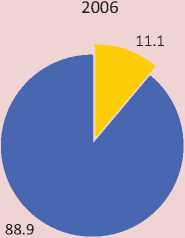
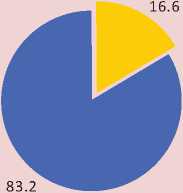
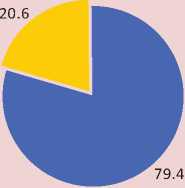

Federal budget
Budget of the Komi Republic
There were positive changes in the approximation of the conditions and living standards of rural and urban populations, as well as the financial state of the industry. In the prereform period all agricultural enterprises were profitable. The level of profitability of agricultural production corresponded to the optimal rate (40 – 50%), allowing to carry out the process of expanded reproduction.
Market reforms were accompanied by the decline in agricultural production, the degradation of the production potential and the peasant community as well. The main reasons for the instability of the agricultural sector are: the disparity in prices for agricultural products and material resources, provided the village; the insolvency of consumers and untimely payments for the sold products, the reduction of state support; the violation of corporate bonds, going public agro service companies designed to serve the rural producers, made them virtually independent of the village workers; the liberalization of food imports; falling effective demand; backward technologies, the high level of depreciation of fixed assets; the extremely low living standards of rural workers, lack of skilled personnel in the industry, lack of management, inadequate infrastructure.
The investigation of the effect of agrarian reform on the stability of individual industries and social types of households (for example, the Republic of Komi) showed that since the mid-1990-ies meat poultry is stably functioning on the basis of self-regulation. Agricultural companies specializing in the production of eggs, pork, venison and fish, while maintaining government support are able to develop dynamically. Agricultural enterprises in the cattle-breeding industry without external assistance can not get enough profit to build productive capacity and implement the expanded reproduction. Households showed the stable activity in the 1990-ies. In the last decade in most northern regions there are absolute and relative reductions in production. The vast majority of households refer to the consumer.
Taken in recent years the measures of state support for agricultural producers, in connection with the implementation of the national project “Development of agriculture”, although ensured the tendency of growth of the production of certain products, but have not led to sustained economic growth. Major shifts in the quality of life in rural areas have not happened yet.
The main directions of sustainable agriculture development are associated with the use of new technologies and balanced reproduction of the resource potential, the production of organic products, which allows to receive rental income, the formation of mixed and multifunctional agriculture in the countryside, the creation of scientific and information support, and increased state support for agricultural producers.
The actual trends of agricultural and rural development of the North contradict the principles of sustainable development. It is required to further study of ways of sustainable development and agricultural production in rural teritories and creating the necessary mechanisms for such a transition.
Список литературы Sustainable agricultural sector development of the north zone: state, factors, directions
- Ivanov V.A. The intensification of agricultural production: the problems of development and effectiveness. Moscow: Science, 1990.
- Ivanov V.A., Terentyev V.V. The state and prospects of the agricultural sector of the Republic of Komi. Syktyvkar, 2010.
- Ivanov V.A., Terent’ev V.V., Maltseva I.S. Factors and conditions for sustainable agri-food sector development and rural territories of the North. Syktyvkar, 2011.
- Buzdalov I.N. Agriculture under the pressure of cross-sectoral and macroeconomic strains. Economics of contemporary Russia. 2009. Nо. 3. P. 28-40.
- Economic and social indicators in the Far North and equivalent areas in the 1998 -2010 years. -M., 2011. -URL://http.www.gks.ru/bgd/regl/b10-22/Main.htm
- Agro-industrial complex of Russia in 2009. -Moscow: Ministry of Agriculture, 2010. -P. 339, 340.
- Agriculture, hunting and forestry in Russia. 2009: stat. book/Rosstat. -M., 2009. -Pp. 406-407, 410-413
- Regions of Russia. Socio-economic indicators. 2008: stat. book. Rosstat. M., 2008. Pp. 194-201
- The development of agro-industrial complex of the RSFSR: stat. book. Goskomstat of the RSFSR. M., 1991

